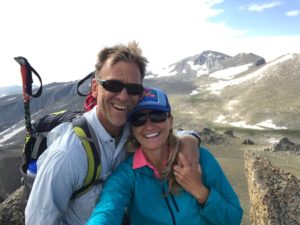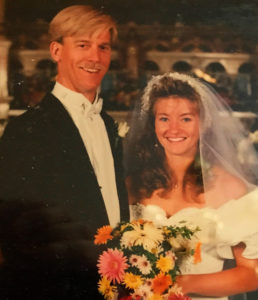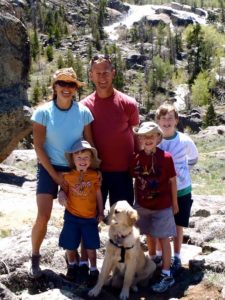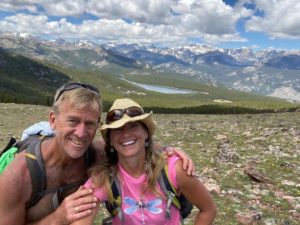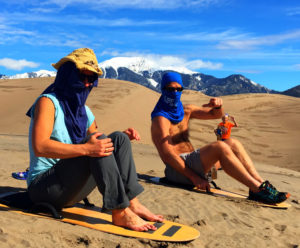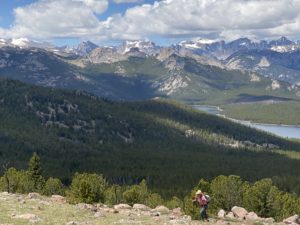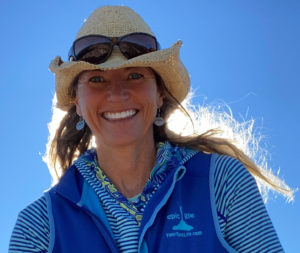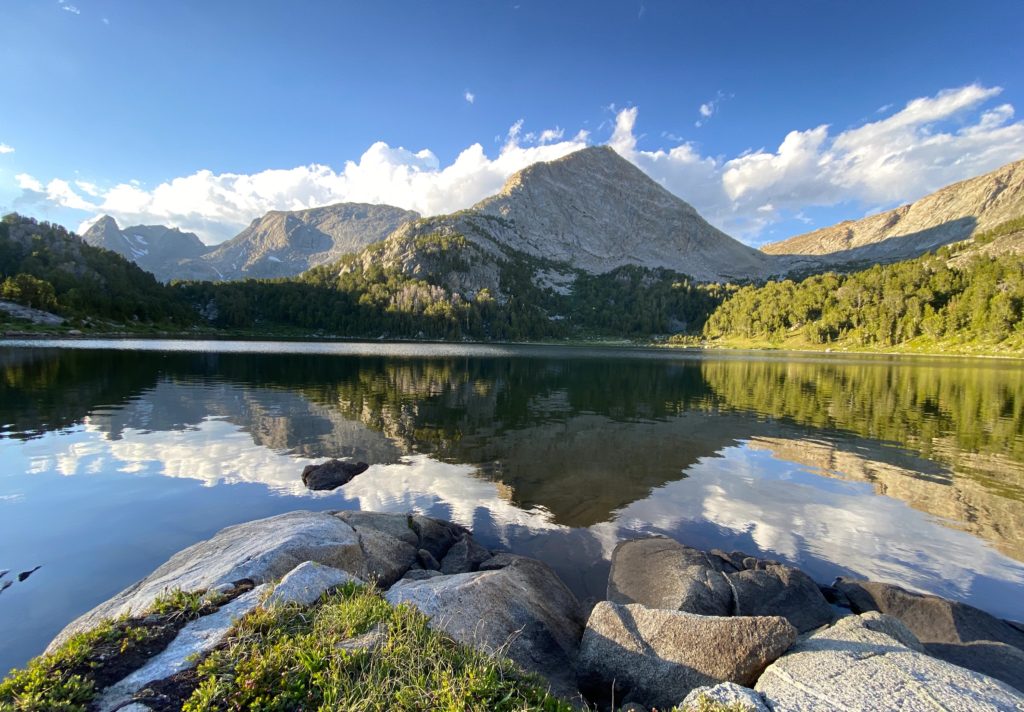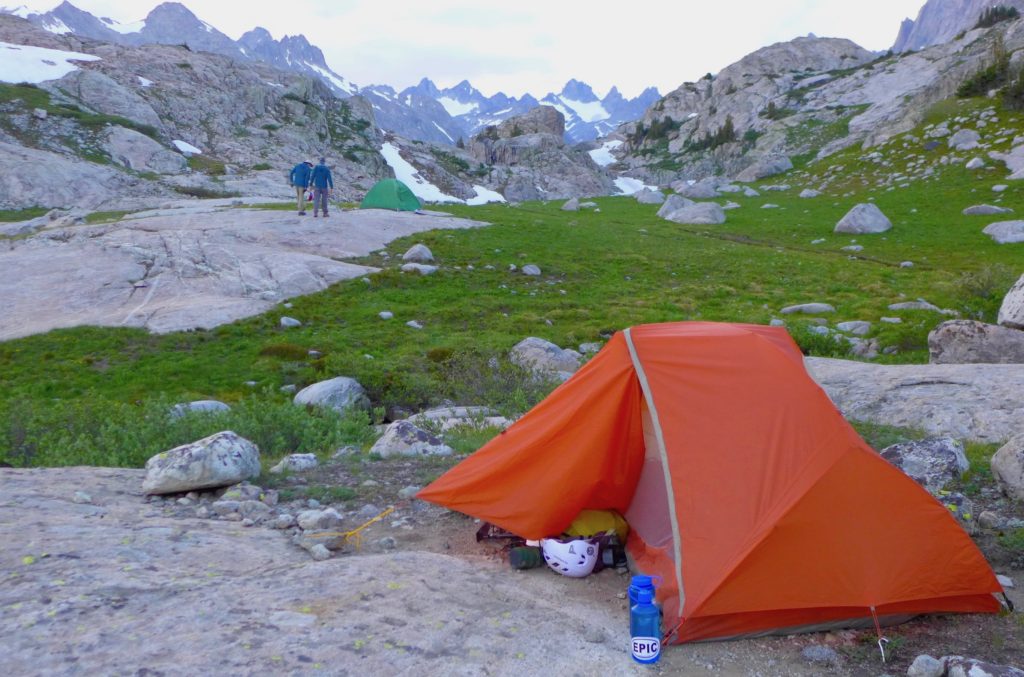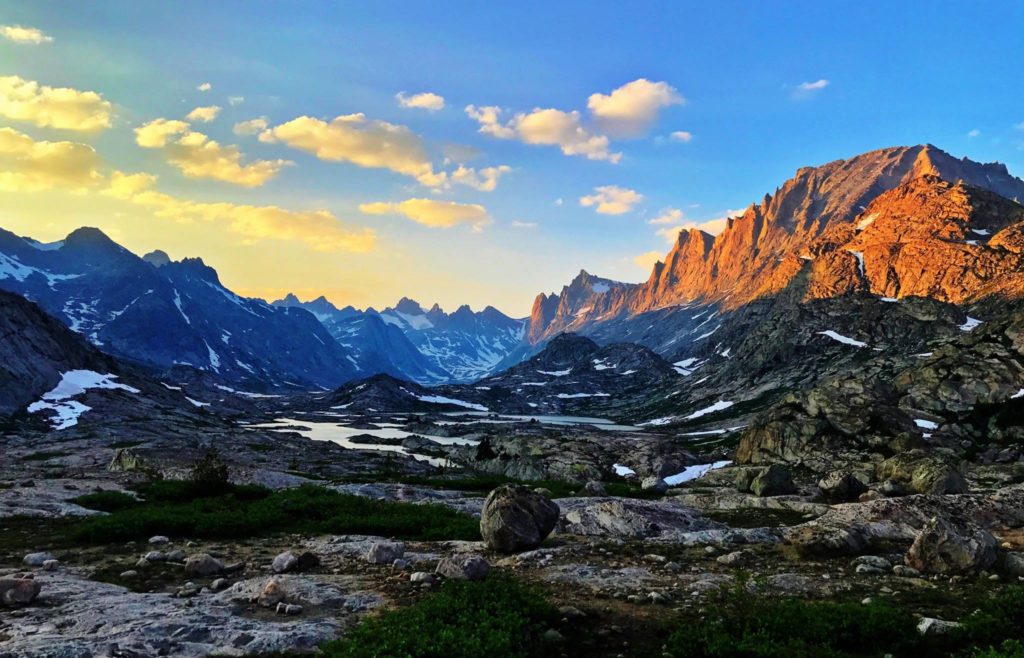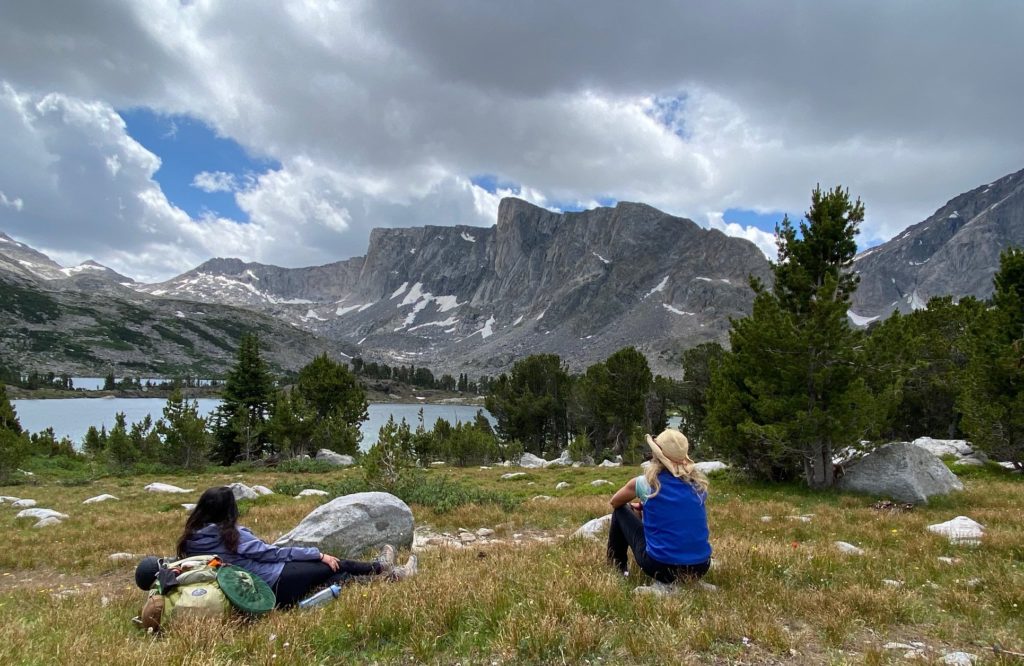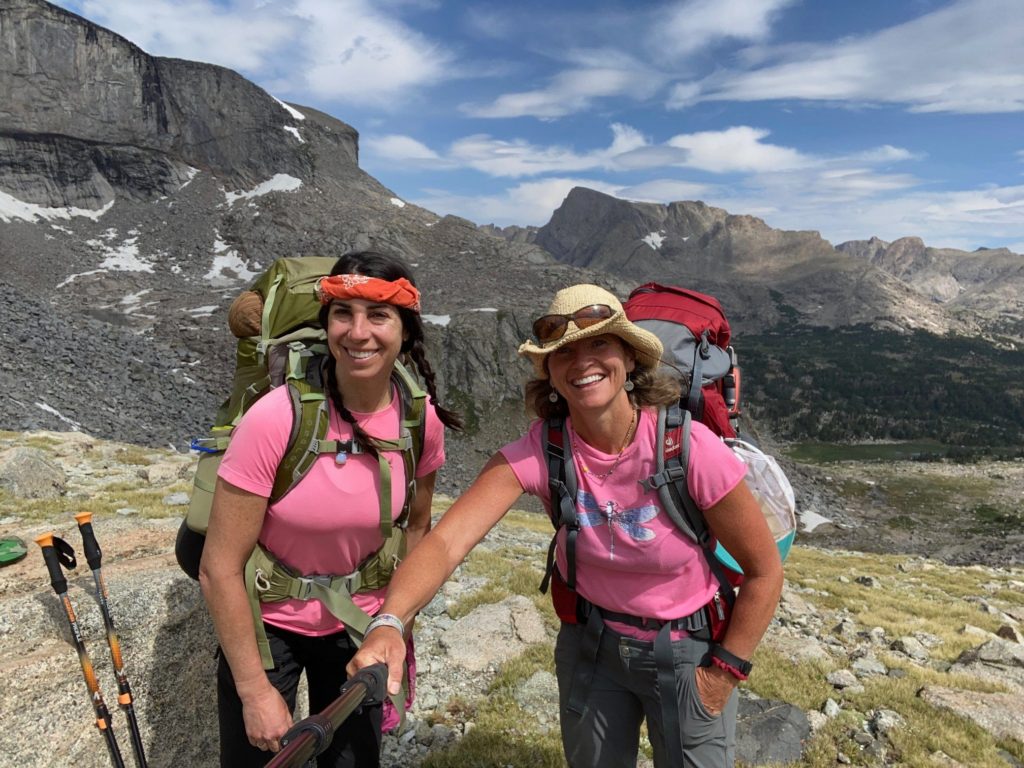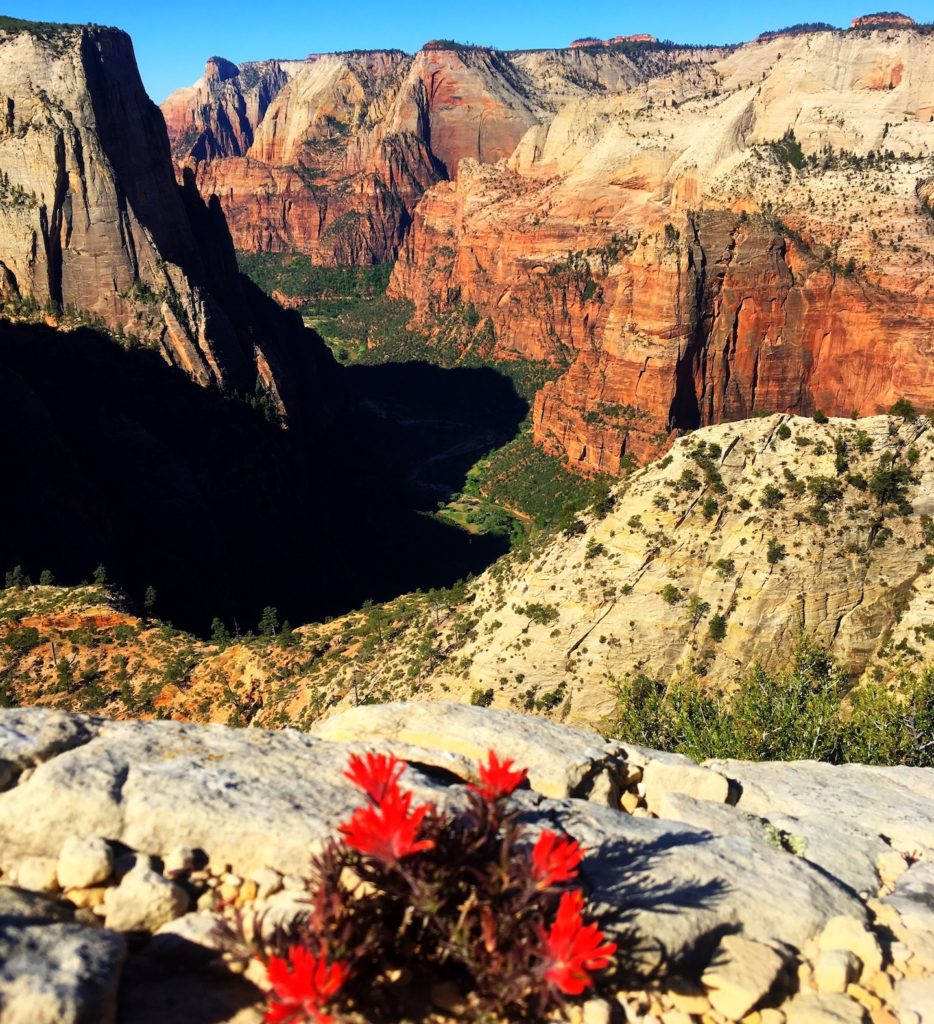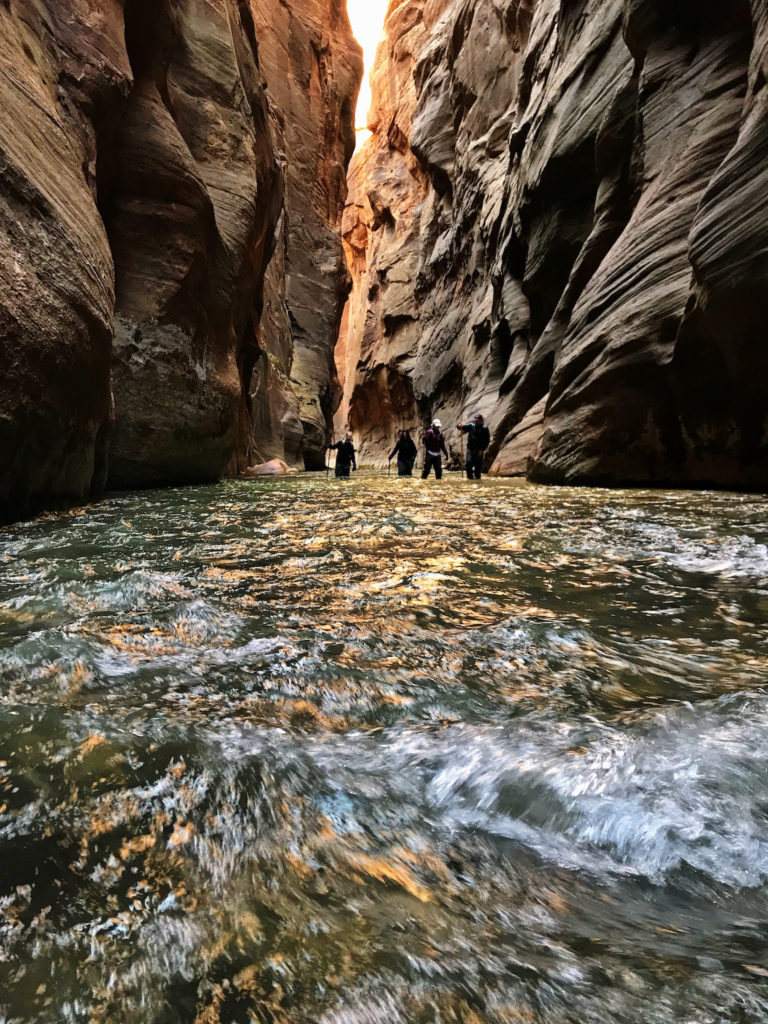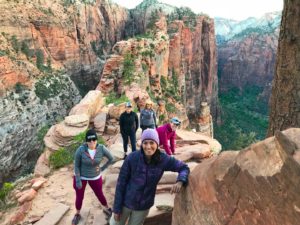September 10th, 2021
“And she loved a little boy very, very much, even more than she loved herself.” – Shel Silverstein
I recently embarked on a 4-day backpacking adventure with my youngest son, Fin, who is 14 and a freshman in high school.
We started at Big Sandy Opening, in Wyoming’s southern Wind River Range. Our itinerary would include time at Big Sandy Lake, North Lake, Jackass Pass and Mitchell Peak, and Clear and Deep lakes.
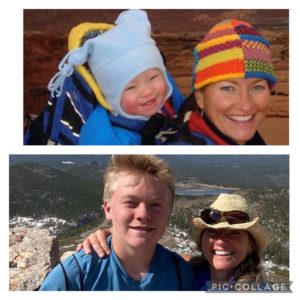
Fin and I, then and now.
The first time Fin was on this trail was in late August six years ago when our family backpacked to Clear Lake for Labor Day. I remember planning that adventure. Jerry and I, and Fin’s older brothers, Wolf and Hayden, all agreed it would be best if we required Fin, the youngest son by 5 years and who was much smaller than his brothers at the time, to carry only a fanny pack. We didn’t want the adventure to be too difficult for him and we figured this would lead to minimal complaints on the trail from the youngest/smallest member of our family.
It worked. With a fanny pack containing only a small bag of Cheetos and a little pocket knife, Fin would skip ahead of us, arms swinging in joy. Whenever Jerry, I, Wolf, or Hayden complained about the crushing weight of our packs, Fin would exclaim, “my back doesn’t hurt at all!” before frolicking up ahead.
On this day, as Fin and I set out on our adventure, he was singing a different tune. Now, towering over me at 5’11” and weighing 160 pounds, Fin carried more than a little fanny pack. A lot more.
Fin is in a growth spurt, but even if he wasn’t, food has always been Fin’s love language. And his oversized pack proved it. I was sure we packed too much food, and yet didn’t want to risk not having enough food, or to be missing various snacks Fin had requested, including but not limited to Gardettos, Cheetos, hot dogs, homemade cookies, beef jerky, and Red Vines.
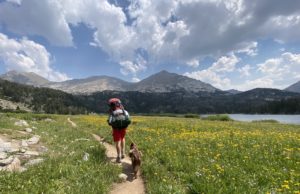
Fin and Chewy leading the way to Big Sandy Lake.
Fin and I were embarking on our “mother-son rite of passage” adventure. Several years ago, I had the idea to take each of my sons on a 4-day wilderness adventure the summer before they start high school. The inspiration for this came from my wanting to connect in a unique and meaningful way with each of my sons, individually, at a point in their life when they were pursuing greater independence. It started with our oldest son, Wolf, six years ago, and a year later, I took our middle son, Hayden. This summer it was Fin’s turn.
At 53 years old, and after a 5-year hiatus since the last one, I worried about whether I could do it. I am grateful for good health!
Fin is short for Finis (pronounced Fine-us.) We named our youngest son after the late Finis Mitchell, a legend in these parts.
Finis Mitchell was born in Missouri in 1904 and when he was five years old, his father moved the family to Wyoming. At age 22, Finis went to work for Union Pacific Railroad, and a couple of years later, married Emma Nelson. They had two children, Anna and William. During the Great Depression, Finis was laid off from the railroad, after which Finis–an explorer and naturalist since childhood–and his wife started “Mitchell’s Fishing Camp” in Big Sandy Opening, in Wyoming’s southern Wind River Range. For seven years, Finis and Emma took people on horses they borrowed from a local rancher to go fishing in the high country.
From an article published on WyoHistory.org by Rebecca Hain on August 24, 2018: To increase the number of fish for the success of their camp, and also as part of a larger citizen volunteer effort coordinated by the Wyoming Game and Fish Commission to introduce more trout species into the waters of the Wind Rivers, Finis and Henry (his dad) hauled in small trout—fingerlings—to lakes near their camp. In 1931, Finis and his father took six horses, each loaded with two milk cans of water containing about 1,000 fingerlings, up rough trails to empty the cans into various lakes. The fingerlings were supplied by the fish hatchery at Daniel, Wyo. In this tricky process, the water in the cans had to be oxygenated by sloshing around. Burlap covered the cans, letting air in but keeping the trout from spilling out. During the 1930s, Finis, by his own estimate, stocked about 2.5 million fingerlings in 314 lakes.
In other words, the people who travel from all over the world to enjoy the spectacular trout fishing found in the upper reaches of the Wind River Range, have Finis Mitchell and his family to thank for it.
I shared all of this with Fin as we hiked up the trail.
Fin and I brought along our puppy, Chewbacca, who goes by “Chewy.” We rescued Chewy last September when he was just 6 weeks old and the size of a guinea pig. Fin and Chewy were immediately smitten with each other and we figured it would be fun to have Chewy along. And besides, Chewy would carry his own pack full of food.
It wasn’t long and Fin requested a break. We found a rock that was big enough for him to sit on while not removing his pack and having enough room for its weight to be supported. We would do this many more times, and after the first few, I caught myself thinking, at this rate, we’ll never get to camp. Thankfully I noticed my agitation and reminded myself we had all day to cover 7.5 miles and that in fact, Fin wasn’t complaining. He simply was asking for short rests along the way.
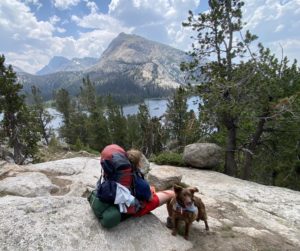
Fi and Chewy taking a break during the last big uphill on Day 1.
I was fortunate enough to get to walk Fin to and from school from Kindergarten all the way through fifth grade. What a blessing that was as I have so many wonderful memories of conversations shared as Fin held my hand and we walked to and from school.
From the earliest of our school walks, Fin’s curiosity was revealed, and he noticed everything. We stopped frequently, to get a closer look at a particular bug, patterns on the street, birds, sounds in the air, the clouds, and more. He noticed that our shadows made our legs look unusually long during the morning but then were nowhere to be found on our walks home from school. Fin was full of wonderment, and joy and delight came easy to him.
On many such occasions, I would think to myself that Fin was teaching me something valuable–to slow down and to look around. Fin was never in a hurry, fascinated by seemingly ordinary things and I remember thinking about how I could benefit by applying such a philosophy to my own life.
So remembering all this, every time Fin requested a break, I agreed to it. He’d say, “Sorry.” And I’d say, “Don’t be sorry. We have all day to get to camp.” I felt bad that he felt the need to apologize. I have a lot of energy and enthusiasm, which may translate to a faster pace when hiking, or doing anything for that matter. I remind myself how annoying this could be to others, including Fin.
One of the reasons I love spending so much time in the wilderness is it’s the easiest place for me to be present, and in the moment. In almost all other situations, I tend to be future-oriented, always thinking about things to come, about ideas and possibilities, and in the process risking missing what’s happening in the moment.
As Fin and Chewy and I hiked, I felt that familiar sense of belonging and presence and a relief came over me that I would indeed be here with Fin, and only here. And oh, how I had been looking forward to this!
I have kept a record of many of the things Fin said or asked during those hundreds of school walks, as well as at other times.
One time after picking him up from preschool we hurried home and I made a fast lunch because I was apparently starving. As we sat next to each other at the kitchen table, and I wolfed down my lunch, Fin remarked, seriously and with sincerity, “Good job chewing like a cow, Mommy.”
Another time I came downstairs wearing a dress, which was unusual, and Fin, upon noticing, complimented me, saying, “I like your costume, Mommy.”
Fin could be serious, too. One time on the way home from preschool, Fin inquired, “Mommy, how many lives do we have?”
I love hiking with my sons. If we’re wandering down a mountain trail, I don’t have to work to prompt the boys into conversation. Walking somehow inspires them to talk, and to share more openly about what’s on their mind than they would normally share.
Since our sons were babies, they have been on the trail with us. We carried them in front packs and then child-carrying backpacks until they could use their little legs to hike on their own. For better or worse, our sons never really had a choice when it came to hiking and spending time outdoors.
Jerry and I were married for seven years before starting our family. While I was pregnant with our first son, Wolf, Jerry and I would talk about the kind of life we wanted to provide for our family. We both love the outdoors and believe strongly that time in nature is important to one’s mental and physical health, and that it can provide inspiration and facilitate self reliance and leadership while fostering curiosity and a connection with the natural world.
So, when our boys were young, we didn’t ask them if they wanted to go hiking. Rather, we’d say, “Today we’re going hiking!” Jerry and I considered time spent outdoors to be a core value for us and our family so if we were serious about it, we’d have to walk the talk.
It’s not easy to be an outdoor family. It doesn’t happen naturally. It takes a lot of extra work to take a baby or small children into the wilderness. You have to accept that it will be more work and go through with it, anyway. I have so many memories of trying to get our small sons out the door and onto the trail. At times it was tempting to just throw our arms up in the air and cancel, but we persisted. And what a difference it has made.
We came up with tips and tricks to make it easier and more enjoyable for the boys. Our most effective strategy was implementing the “trail fairy.” We’d be spread out in a line on some uphill trail and one (or more) of the boys would be complaining, wanting to stop. Jerry or I would secretly toss a baggie into the air and it would land up ahead on the trail in front of the sons. (Or Jerry or I–whoever was up front of the pack, would deposit a small bag in the middle of the trail for an oncoming son to discover.) The little bag would have treats in it with a note saying “You are doing amazing” or “what a great hiker you are!”) . When our sons would discover these treats and notes, it would energize them and provide enthusiasm that was good for another quarter or half mile of hiking.
On some of our usual hiking routes, there are prominent rocks and other landmarks that over the years we named Rootbeer Rock, Butterfinger Rock, Kit Kat Corner, and so on. These were points to shoot for when the boys were little and tired and complaining, where we’d promise the boys their favorite treats.
I’m pretty sure that if we had asked our boys if they wanted to go hiking, they may have declined, especially some of the longer ones we’ve taken over the years as a family. As a teenager, I’m not sure I would have chosen a hike over time with my friends, a movie, or just about anything else that was easier and more fun. In fact, I’m pretty sure, if asked, I wouldn’t have.
I was raised in Wyoming, and when I was young, my parents would take our family on seemingly never-ending road trips through the Red Desert, up the Loop Road and through South Pass City, and/or to Yellowstone and back in a day. At the time, I didn’t necessarily love those experiences and I probably wouldn’t have chosen to do them if given a choice, and yet those experiences continue to positively impact and inform my life. I am hoping, and trusting, that all of the hikes and outdoor adventures we’ve taken our sons on will do the same.
Fin has proven on several occasions what a capable hiker he is. When he was only 9 years old, he hiked a few 20-mile-plus day hikes on our Switzerland stop during our first European vacation. When he was 11, he hiked several 20-mile-plus days during our family’s pilgrimage on the Camino de Santiago. At age 12, he hiked for miles climbing volcanoes and traversing glaciers in Iceland, and he’s done 18-mile family day hikes in our beloved Wind Rivers. He did all of these with little complaint. (In fact, when I picture him during many of those hikes, I can see his happy gait, with his arms swinging as he hiked.)
Still, it would not surprise me if at times Fin and his brothers wished they had been born into a different family, at least a family with a different mom!
I wondered if Fin had been thinking this in the weeks before our adventure, and particularly now, as his feet were sinking into the ground with each step given the weight of his oversized backpack.
After a few miles, I asked Fin what his goal was for the trip and he said, “To be able to climb the mountain and to have fun.” I told him my goal was to have fun and to cherish the time in the mountains with him. I thanked him for sharing this adventure with me.
In recent years, as Fin has gotten older, I’ve felt a distance forming between us. I think this is normal. It happened with the older boys, too. When a child reaches a certain age, he starts to push away from his parents. He is growing up and wants more independence. It makes sense that boys don’t want to cuddle with their moms like they did when they were toddlers. Nevertheless, I was longing for four days of one-on-one time with my youngest son in the great outdoors.
As we walked, I reminded myself to speak to Fin in his language–to ask him about things that I know he’s interested in and passionate about. I asked him about the video games he loves playing, and he shared, quite enthusiastically, about some of his favorites. Then we talked about his various friendships. We went down the list of his best friends and for each, I asked him what he likes and values most about each. This requires some reflection on his part but he comes up with thoughtful responses for each, and in the process, I learn a little more about Fin and the qualities he values in a friend and friendship, and in people for that matter.
Before long, we spy water and arrive at Big Sandy Lake. We are thrilled to have most of today’s distance behind us and we are both looking forward to an extended break that will, at least for Fin, include lots of eating.
Fin has always loved to eat, and is a master at it. Right now, he’s experiencing a significant growth spurt, so his appetite is even more noteworthy. (He has grown 8” in the last 1.5 years and the doctor predicts he could grow another 6”.) It can sometimes feel like a full-time job keeping him fed. It’s a game for me every day to try to figure out what we’ll be having for dinner before he texts me from school to ask me, “What’s for dinner, Mom?” And since I’m not above bribing when it comes to inspiring my boys to do things that are good for them, food has been a valuable currency.
Three summers ago, when we backpacked 160 miles of the Camino de Santiago in northern Spain, Fin hiked particularly enthusiastically no doubt in large part due to the fact that we’d get to eat a delicious meal about halfway through the hike, not to mention there were other stops for soda pops or bread or ice cream along the way.
On our first European trip in 2016, we went on some challenging epic hikes in Switzerland. The first was particularly grueling because Jerry and I mistook one hike’s elevation gain of 1,200 meters for 1,200 feet. Oops. The boys were demoralized by all the uphill early on. We had ascended 1,200’ in the first two miles, not to mention it was raining. But thankfully, there were little villages and restaurants throughout the hike, and once the eating started, the complaining stopped. By the end of our 24-mile trek, we had enjoyed several Lindt and Milka chocolate bars, fondue, pizza, ice cream, soda pop for the boys, beers for Jerry and I, and other tasty treats.
Fin and I chose a flat rock near the end of Big Sandy Lake for our extended break and picnic. It felt good to take the loads off our back and to get off our feet. We lingered at the lake, and were mostly quiet as we ate a hearty lunch. I reminded Fin that the more we ate and drank, the lighter our loads would get.
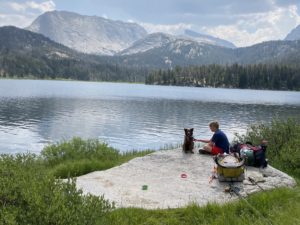
Fin and Chewy, taking an extended break at Big Sandy Lake.
After our picnic, Fin and I had what would be the hardest part of the day’s hike ahead of us. We only had a short distance remaining, but it would be a grunt that included a gain of 600’ under a blazing sun. As we put our packs on and started for the hill, I told him we could stop for a quick rest after every single switchback if that would help, and so we did that and it did help.
As usual, we were rewarded for our uphill effort. Not only did we have awe-inspiring views of Sundance Pinnacle, Warbonnet and Mitchell Peak in front of us, we had fantastic views of Haystack, Steeple, East Temple and Temple Peaks to the back and east of us. And ahead of us was a field of yellow and purple wildflowers.
Then suddenly, while we were bent over catching our breath, a large dark shape–a moose–emerged from the woods and lumbered across the trail in front of us and through the flowers. We watched as the majestic, 1,000-pound animal continued down to the outlet of North Lake to get a drink. It was a great sight and it energized us.
It was early afternoon when we reached the area where I planned to set up camp. Unfortunately, it would include one last steep hill to climb. Fin, who still hadn’t complained about the weight of his pack, looked a little demoralized when he saw this final hurdle. It was hot, 90 degrees without a breeze, and did I mention, there were mosquitoes. Plenty of mosquitoes.
I instructed Fin to sit on a rock with Chewy while I went up the hill to see if I could find a good place for camp. After slogging up the hill, I was pleased to find us a great site.
Relieved that the hike to our destination could now end, I dropped my pack and went down to fetch Fin and Chewy. I offered to take Fin’s pack for this last grunt, and he was so very appreciative. As I was taking his pack from him, it reminded me of the hundreds of times I did this very thing every time I walked to fetch him after school. It was the first thing I always did. I’d take his pack to carry it home for him.
As I remembered this I felt a little choked up and as if I might cry. Right before me was the little version of Fin, with his long reddish hair and happy to see me as I greeted him after school and took his backpack before starting our walk home. And at the same time I was seeing the current tall and handsome “all grown up” version of my Fin.
There were some gray clouds forming and rain seemed imminent, so I suggested we get the tent set up in short order. Drenched with sweat, tired from the hard hike at altitude with a heavy backpack, and annoyed by mosquitos, Fin was quick to help me dig the tent out and get it set up. We had chosen an area in the shade for our temporary home and once we had it set up, I insisted Fin get inside and take a nap. He didn’t object and was asleep almost as soon as I zipped the tent’s door behind him.
As Fin and Chewy napped, I unpacked and organized what would serve as a small kitchen/eating area about 100 yards from the tent.
I made myself a cup of tea and found a place in the shade to sit. I thought about my Finis and brainstormed words to describe him using the letters of his name. I decide F is for fun/funny. Fin has always loved playing and he’s great at finding ways to have fun. He’s also quite funny and likes making jokes and making others laugh. In fact, in the past he’s mentioned that he might want to be a comedian. I don’t know how serious he is about that, but if nothing else shows the high value Fin places on humor. Whenever I send a text with Fin’s name in it, Siri changes Fin to Fun. I have stopped overriding Siri on this because fun fits when it comes to Fin.
The first I in his name is for Imaginative. Fin has always had a curious mind. I can see his wheels turning when he’s observing something or thinking about a question or a topic we’re discussing at dinner or on a road trip. He has a huge imagination and likes to use it. N is for Negotiator. Fin has been a master negotiator since he was little, and while this can be a disadvantage for his parents, his ability to negotiate will likely serve him in the future. The second I in his name is for Insightful. For as long as Fin has been able to talk, he has been insightful. He’s extremely observant and often shares insights that demonstrate an intuitive understanding about something he sees or learns. And finally, S stands for Sensitive. Fin has always been a sensitive and thoughtful person. He cares deeply about the people in his life and he picks up on the way others are feeling.
A little more than an hour passed and I woke Fin up. Given his mountain climb the next day would require an alpine start, I wanted to ensure he’d be able to sleep once night fell.
I had picked this camp site because from it, we had a view of Mitchell Peak. The itinerary for our mother-son rite of passage adventure included a solo mountain climb of Mitchell Peak for Fin on Day 2. To climb the mountain would mean traveling off-trail and up and over rugged terrain, at altitude, with an elevation gain of about 2,400’.
When Fin and Chewy emerged from the tent and joined me in our eating area, I pointed out Mitchell Peak, and the route he would take to climb it. I explained that the mountain climb would be hard. I shared that it’s not only a steep endeavor but that with the altitude he would feel out of breath probably from the outset and that it would only get harder the higher up he got. I told Fin to expect it to be difficult and reiterated that regardless of one’s fitness level, climbing a mountain at altitude is hard.
We’d have a 5am wakeup and a 6am departure. I opt for early starts on summit days for safety reasons. In the high country, a clear blue sky can be filled with clouds rather quickly, often developing into a storm in the afternoon. I’ve had to turn myself around, and expeditions I was leading around, just short of reaching the summit after clouds came in quickly. I wanted to set Fin up to have the most time, and the best chance of summiting in case the weather changed.
Jerry and the boys had surprised Fin with a whittling knife. While I cooked us a dinner of delicious chicken-flavored ramen, Fin whittled as Chewy lounged near his feet.
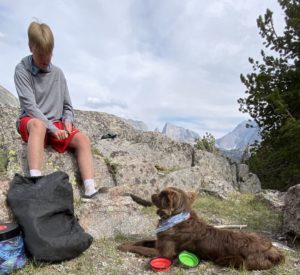
Fin, whittling while Chewy looks on.
As Fin was eating, I showed him the book, Wind River Trails, written by Finis Mitchell in 1975. I asked Fin if I could read aloud “A Mountain Man,” a prayer written by Mitchell on the last page in the book, and he said yes.
He who labors to reach the summit of a mountain seeks solace and tranquility. He is neither greedy nor selfish. He finds time to help others less fortunate than himself. He loves the great outdoors and all forms of life; the trees, the flowers, the grasses of the land and the land itself. He loves the music of cataracts from glacier to sea. He also loves the peace and quiet when life-giving streams linger momentarily in valley or lake along their way. He makes happy tracks in many snows which melt away, leaving no trace of man’s visit to the wilderness. He finds time to do everything needful by never letting time find him doing nothing. He is a man among men.
He always awakens facing the east from whence the sun gives life to all things. As the day advances, he strives to help others attain greater heights from north to south. When the day is done he faces the west as the setting sun beckons him into peaceful slumber and puts the world to rest. He is thankful the Earth provides his existence and for the privilege of just being here; thankful to be on the summit of a mountain which shall stand forever as a sanctuary to God and man.
For him, may the winds that blow his way be always mild and the rains that fall upon him be warm and gentle. May the path he selects to follow through life be decorated with lilacs so the beauty and fragrance of the land be with him all the days of his life. May God be with him along his way and guide him through the darkest nights. Amen.
Fin said he liked it.
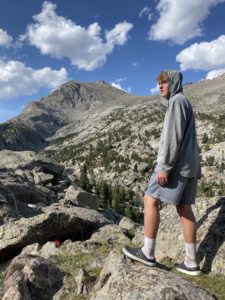
Fin, with Mitchell Peak in the background.
I told him the Mitchell Peak he would be climbing tomorrow was his mountain and that I was proud of him.
After dinner, we played some gin rummy. The score was 2 games to 1, with Fin leading, as we headed to the tent for the night. It was still light out so sleep wouldn’t come easy even though we were dead tired.
Fin has a great sense of humor and loves all things funny so I offered to play an audiobook by comedian Jim Gaffigan called Food: A Love Story. I figured I might get some points given I had selected a book that combined two of Fin’s passions–humor and food. It didn’t take long and we laughed ourselves to sleep. (Two particularly funny excerpts: “If aliens studied Earth, they would come to the conclusion that the United States is somehow consuming food on behalf of other countries.” and “I don’t know much about grammar, but I think kale salad is what they call a “double negative.”)
The next morning I woke before the alarm. I quietly got myself and Chewy out of the tent and headed for the kitchen area. I had one objective and one objective only: To boil water and get a cup of coffee brewed as soon as possible. Until I was sipping a cup of coffee, nothing else could be accomplished.
I was relieved to see the sky was clear. As an adventurer and adventure guide, there’s nothing I love more than a clear sky. It would be a perfect day for my youngest son to climb a mountain.
After finishing my coffee, I woke Fin and instructed him to get his hiking boots on and meet me in the kitchen.
He was still coming out of his slumber and I was deliberately trying not to rush him, but felt the need to revisit the day’s objective. I asked him to look at Mitchell Peak and review the route I was recommending.
Fin snarfed a toasted cheese bagel and drank a cup of hot apple cider as he looked at the mountain. “It doesn’t look too bad,” he said. I was comforted by his confidence, but as his mother, also worried about all that could go wrong.
Out here in the wilderness, the stakes are high. If something goes wrong, we’re a long way from help. Fin is an experienced hiker, and he knows to be careful, but I worry about him while crossing boulder fields or falling while ascending a steep pitch of granite and hitting his head, getting too close to the edge when on the summit, and on and on and on. I catch myself going down this nervous and anxious rabbit hole and remind myself that I had the same overwhelming worries when Hayden and Wolf each were in this position, preparing to climb Mitchell Peak, and they did fine. And besides, this was my idea. But still…
I know it’s normal for a mother to worry and to want to protect her children. But I also know it’s critical to trust and to let go. With two sons who are ages 21 and 19, I know this firsthand and yet, I still struggle with it. Even with the two oldest sons launched and away at college, it hasn’t become any easier.
Fin is the baby of the family and I still see him as the toddler with long hair who liked to hold my hand and who trusted me to kiss his owies whenever he got them.
After Fin finished his bagel and cider we packed up and started up the trail. Chewy and I would hike with him as far as the end of North Lake, and get him started up the mountain, at which point we’d go in a different direction and meet him at some point during his descent of Mitchell Peak.
As we started up, the sun was shining its first light on the tops of the granite peaks all around us. My trail name is “Sunrise.” Sunrise is my favorite time of day and I love to be on the trail before the sun comes up. Today we timed it perfectly. The top half of the dramatic Warbonnet Peak was painted with bright sunlight as it was reflected below in the green and glass-like waters of North Lake.
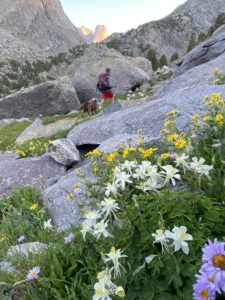
Fin and Chewy, starting toward North Lake.
There were wildflowers everywhere, lit up by the day’s first light, and it was so quiet. All we could hear was our breathing, and the occasional click of my trekking poles. There wasn’t a breeze and we were the only ones on the trail. I was in Heaven, and feeling blessed to be experiencing the spectacularly beautiful morning with my youngest son.
As we started up from North Lake, Chewy was up to his nose in wildflowers as he tried to keep up with Fin. After a little bit of route-finding, I instructed Fin to follow the spring up through the first half of the climb.
Then I hugged him and told him I loved him and that I was proud of him. I pointed to a point high on a ridge where Chewy and I would be waiting for him to descend the bottom part of the mountain with him.
As he left, I yelled after him, “You’re the best Fin in the world!” which is something I’ve been telling him since he was little.
As Fin continued up and away from us, he looked back and waved. As I watched him, suddenly it was as if I was watching him through the chain link fence at Baldwin Creek Elementary after walking him to school and he was looking back and waving. After walking Fin to grade school each morning, I was always careful to not walk away until he was done waving. I never wanted to turn my back to him if he was still looking and waving. In his 4th grade year, he suggested near one of our first walks of the school year, “How about I wave three times and then you can go.” The next year, he’d say he’d wave when he reached the monkey bars and then I’d leave.
I felt tears in my eyes as I watched him wave at me. My little Fin with the long reddish hair was now a tall young man. What a big boy, I thought.
When Fin was born, we were surprised by his size. He was almost 9 pounds! Like his two brothers, he was delivered by c-section. I gained more weight when pregnant with Fin than when pregnant with Wolf and Hayden, so I figured he’d be a bigger baby than his brothers were. But still, we were surprised to have such a large bundle, and his long unruly red hair and bright blue eyes made him such an adorable baby. Meeting him for the first time was one of the greatest days of my life and I’ll never forget looking into my Finis’ eyes for the first time.
Because I had delivered via c-section, it took a little longer before I could hold Fin a second time, but when I did, it was magical. He lay on my chest, nursing for the first time, and I was in Heaven.
Later that night in the hospital, I could hear Fin coughing. Throughout the night, I could hear his little cough. I worried because it seemed like he was struggling more than necessary to breathe. I couldn’t sleep because I was filled with worry. It wasn’t long and we were informed the doctor thought we should get Fin to Denver to the Children’s Hospital to examine his lungs more closely. They assured us that everything was probably fine, but the hospital in Denver would be better able to assess and treat any possible conditions that were causing Fin’s coughing and the resulting difficulty he had with breathing. Fortunately, I was able to fly on the plane with him. After five days of monitoring and tests, Fin’s breathing issues were resolved and we were sent home.
I think of Fin’s little baby cough now and how labored his breathing was in those first days of his life, and I wonder–and worry–if he’s feeling a similar struggle now, what with the increasing altitude he was experiencing while climbing Mitchell Peak.
Chewy and I headed up in a different direction. I planned to find a boulder somewhere beneath what’s called the Dog Tooth, on which to sit and reflect. I had equipped Fin with a walkie talkie in case of emergency. A while later, after Chewy and I got situated on a boulder, Fin’s voice came over the radio telling me about a cool spider that was suspended on an elaborate web between two boulders he was climbing.
Fin has always been a keen observer of the natural world, and has a special place in his heart for all critters.
When he was 8, he had a pet boxelder bug he named Reddy. One afternoon, after returning home from school, Fin realized his boxelder bug had died. He was heartbroken. He sobbed for almost two hours. We had a little service and burial for Reddy in our backyard to commemorate the bug’s life.
One Christmas, Fin wrote Santa a letter requesting a “very red fish.” Fortunately, Santa delivered on his wish, but a couple of months later, while Fin was at school and I was fetching dirty clothes from his room, I noticed the fish was dead. Living in a small town, there was only one place to find a replacement, Ace Hardware. Unfortunately Ace didn’t have any “very red fish.” So, unable to pull off a switch, I had to break the sad news to Fin. That was another time of heartbreak and grieving that took some time for Fin to process.
Fin especially loves dogs. Not only our dogs, Buddy and Chewy, but all dogs. When our family backpacked the Camino de Santiago, every day Fin would encounter and cuddle dogs along the way. Throughout our daily treks and along the stops in small villages and towns, there were dogs, and we always made sure to stop and allow for Fin to pet and spend time with them.
I interrupt my memory mining to look through my binoculars in hopes of spotting Fin. I get lucky and find him. I see that he’s taking a break, sitting on a Volkswagen-sized boulder.
Chewy sat curled at my feet, lounging in the alpine tundra, preoccupied with the occasional fly or mosquito. I had to put him on a leash so he wouldn’t follow Fin. We always call Fin “Chewy’s boy,” since they connected so immediately upon their first meeting. I wanted for Chewy to go with Fin to the top of the mountain but Fin and I agreed it would be an easier climb without having to tend to Chewy and carry him over various boulder fields. But as Chewy and I sat there, Chewy’s concern for Fin and his whereabouts was palpable.
Some more time passes and I have some tears. I cry easily when reflecting on Fin’s childhood. After we had Wolf, and then two years later, Hayden, we took a pause. We knew we wanted to try for one more but due to all that was going on in our life at the time, we chose to wait a bit. That’s why there are 7 years and 5 years between Fin and his older brothers. I am thinking of how blessed we’ve been by our Finis, and so grateful that we chose to have a third. Fin has brought so much joy to our family and our life!
I check in with Fin on the radio to make sure all is going okay. “It’s going good, just taking lots of little breaks,” he reports, adding, “there are so many spiders on webs between the boulders. They’re cool.” I remind him to take his time, be careful and to enjoy the experience.
About 90 minutes pass and I hear, “I made it to the top, mom.” A few more tears for me, but I gather myself and exclaim, “Great work, Fin!” I’m so proud.
Most of my tears as a mother have been tears of gratitude. But of course I’ve also cried when experiencing sadness or worry or frustration related to being a mother. Add to that I have so much self doubt about my abilities as a mother, and I can be particularly hard on myself.
For the last 11 years, I’ve worked with and coached many women, and this self doubt and self criticism mothers experience comes up frequently. One time I was coaching a woman who was particularly hard on herself when it came to her role as a mother, and I asked her, “What has to happen for you to believe you’re a good mother?” I ponder this question as I sit on my rock with Chewy, waiting for Fin to descend his mountain. I don’t know the answer.
But I do know that I am proud to have had this idea of a mother-son rite of passage adventure with my sons, and to have kept up the tradition for all three of them.
In fact, this is as much a rite of passage for me, as it is for Fin, and as much as it was for Wolf and Hayden during theirs. This adventure was intended to provide a meaningful time with Fin and to enrich our connection while also acknowledging his growing up and the need for me to let go. I need to allow Fin the freedom that is necessary for him to become independent. That will enable him to find his own way.
Some more time passes and I see that Fin is on his way down, navigating through the steep landscape that is littered with large chunks of granite. He’s descending quickly.
In recent years, during our family hikes, the boys have left Jerry and I in the dust, particularly when on the way back to the trailhead and to our vehicle. I think it’s probably because the hike is mostly behind them and they are excited about that. The boys are great sports to go on our family hikes and they’re great trail company. As a mother, there’s nothing I love more than watching my three sons connect and do what they do when they’re together outdoors, and I will be forever grateful for their generous and adventurous spirits. For their “compliance.”
I see Fin has spotted us and is fast approaching. Chewy’s excited and I let him off the leash so he can run and meet up with “his boy.” I watch as Chewy jumps up on Fin and they enjoy a loving and gregarious exchange.
I greet Fin with a big hug and hold the embrace a little longer than normal. I’m so proud of my Fin. My Finis. We descend toward camp, stopping a few times to eat Red Vines and Munchies before getting back to camp at around 2:30pm.
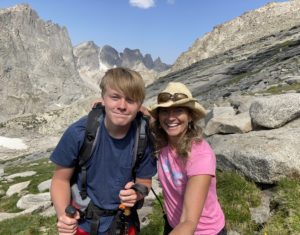
Fin and I, after his mountain climb. (The Cirque of the Towers is in the background.)
Once at camp, I feel elated and relieved. We lounge and Fin takes a short nap. When he awakes we listen to some more Jim Gaffigan and share laughs while playing more games of gin rummy. He leads six games to five.
For dinner, I make my famous “epic buttery, fried cheesy quesadillas.” Fin eats three of them. After our trek to wash the dishes and restock our water bottles, we return to camp.
I ask Fin if he’ll read out loud the poem he chose for this adventure and if I can capture it on video. He is kind and says yes, despite feeling a little awkward about it. He reads Invictus, by William Ernest Henley.
Out of the night that covers me,
Black as the pit from pole to pole,
I thank whatever gods may be
For my unconquerable soul.
In the fell clutch of circumstance
I have not winced nor cried aloud.
Under the bludgeonings of chance
My head is bloody, but unbowed.
Beyond this place of wrath and tears
Looms but the Horror of the shade,
And yet the menace of the years
Finds and shall find me unafraid.
It matters not how strait the gate,
How charged with punishments the scroll,
I am the master of my fate,
I am the captain of my soul.
I listen and watch as he reads, with Mitchell Peak in the background, from a folded printout. I thanked Fin and asked him what he liked about the poem and why he picked it. “Because it’s about bravery,” he said, adding “and because it’s short,” which causes us both to chuckle. I also wonder if he likes it because it’s about sticking to one’s own dignity. After all, Fin is his own person and doesn’t easily conform.
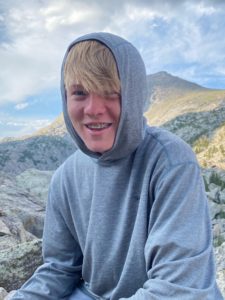
My Finis, happy after having achieved his main objective–a climb of Mitchell Peak.
Tired from our early start and the day’s efforts, we went to the tent early. With Chewy curled up and nestled next to his head, Fin finds sleep quickly. I’m also tired. Exhausted actually. But I take a few minutes to linger, and to watch my youngest son as he sleeps and breathes easily. I want so much to move closer to Fin and to hold him in my arms, like I did when he was younger, but I resist and let him sleep.
I still want cuddles like the ones we used to share when he was little. I remember one day after Jerry and the older boys were already out the door to school and Fin and I had a little more time before we needed to start our walk to preschool. Fin climbed on top of me and asked if we could cuddle for “7 more minutes.” Moments like that were heavenly for me, and I miss them dearly while at the same time knowing we aren’t mothers to raise babies. Our kids are meant to grow up.
The next day there’s no wakeup call. I’ve designed this day to be one of leisure. Fin emerges from the tent at around 8am and I make him his usual adventure breakfast of choice–a cheesy bagel and apple cider. We load our packs with a rain jacket and a lunch, his journal and the deck of cards. I tell Fin that today’s plan is to hike 3 miles to Deep Lake where we’ll have a “deep talk.” I can tell he’s curious and maybe even a little nervous about whatever the deep talk will be about, but I assure him we’ll go easy on the hike and that today is meant to be “chill.”
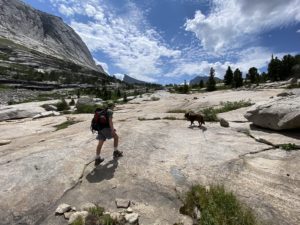
Fin and Chewy, approaching Deep Lake, on Day 3.
We had a great hike and talked about a variety of things, including his job. At the start of the summer, Fin began working his first official job, an internship at our local bike and ski shop. He was loving it so far and he said it was cool to learn how to tune up bikes and to meet cyclists who were biking across the U.S.
We stopped at Clear Lake for a snack and a drink, and recalled memories of the last time our family was here. We spent Labor Day in 2014 camped here and the night was filled with booming thunder, torrential rain, and lightning that lit up our tent. We woke the next morning, on Aug. 31, to a blizzard and our family collectively voted to cut our adventure short.
Next, Fin and I hiked about a mile up a huge granite slab to Deep Lake. (This area of the Wind Rivers is one of my favorites and I’ve spent many nights camped in this area while leading Epic Women expeditions.) Once at Deep Lake, Fin and I had a picnic lunch before I facilitated what has become known by now after doing two of these mother-son rites of passage adventures, as our “deep talk.”
I shared the fact he was conceived in the wilderness, which made him blush, of course, just as it had his brothers, who were also conceived in the wilderness. And I shared with Fin how much I love him and what an honor it is to be his mother.
I told him that the purpose of the “deep talk” was for us to make a promise to one another. I explained that, as his mother, I will always want to protect him, but that I knew that wasn’t possible, and that for him to grow up and become his own person I would need to do some trusting, some letting go.
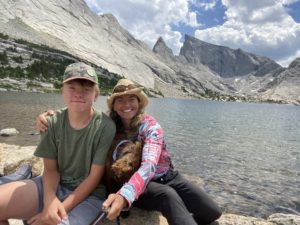
Group selfie at Deep Lake, after our “deep talk.”
I offered to go first. I promised to try to trust him more, and to let go of what likely feels like a tight grasp if he would make a promise to me that would offer some reassurance. For his part, Fin promised he would stick to his values, which he said included “family, friendship, honesty, good judgment, service, compassion, humor, and integrity.”
We agreed to do our best to keep our promises to one another. I told him that I didn’t expect him to be perfect, and that I would almost certainly screw up on my end of the bargain. I explained how hard it is for me to not try to keep him safe, but that I knew I needed to allow him to grow more independent. It was a meaningful conversation and we “signed” it with a hug.
We sat in silence for a few minutes while Chewy dipped his paws in the lake and we watched him try to catch flies. We ate some lunch, and then played a few games of gin rummy. We had agreed at the start of our adventure that we’d play gin rummy and whoever got to 10 wins would be the winner. At this point during our adventure, Fin was leading our rummy series, 8 games to 7. I’m pretty sure I won’t forget our gin rummy games at Deep Lake, because at some point while playing cards there, Fin told me he craved a cucumber. This from our child who doesn’t eat green vegetables!
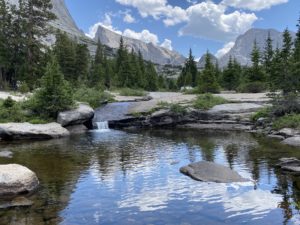
Reflections between Clear and Deep lakes.
The hike back to camp was mostly downhill and we covered the distance quickly. It was hot and Fin and I were both eager to get back to camp and collapse in the shade for a nap. Per Fin’s request, I cooked hot dogs for dinner, complete with Cheetos and nacho cheese on top. After washing the dishes, we played three more games of gin rummy to get to Fin’s 10 and my 8. Fin was the winner.
As we continued lounging, I inserted one more conversation. I shared with Fin that one of the things I do when I coach leaders is I ask them to reflect on the 5 ways they want to be in the world. Fin thought about this for while before coming up with Helpful, Funny, Compassionate, Inspiring, and Brave. I thanked him for playing along and told him I loved the words he came up with.
We had a beautiful sunset, which I took in with much gratitude as Fin wrestled around with Chewy. Before the sun was down, we agreed to head to the tent and listen to some more Jim Gaffigan while going to sleep.
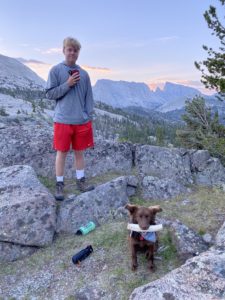
Fin and Chewy at camp, at sunset. (With Haystack, Steeple and East Temple peaks in the background.)
When we unzipped the door to the tent, we both were about knocked out by the stink and stench coming from our tent and the piles of dirty and expired socks and clothes inside.
This reminded me of a spring break camping trip we had taken through southern Utah 8 years earlier. After 6 days and nights of epic hikes and other outdoor adventures, and tent camping in national parks, Jerry and I promised to treat the boys to a night in a fancy hotel. Specifically, we had promised them a night in a luxury resort at the end of the week, complete with robes and slippers all around.
We stayed at the Trump Tower in Las Vegas and indeed, robes and slippers were provided. We lived, and were treated like royalty for the rest of the afternoon and evening. It was an amazing ending to an epic family spring break adventure.
The next morning, as we got into the car following our pampered stay, Fin remarked “I love the smell of hotel air.” We all laughed and agreed.
I reminded Fin of this memory and we both agreed that some “hotel air” would hit the spot about now.
The next day we were both eager to get on the trail and back to civilization so we woke early and broke camp in record time.
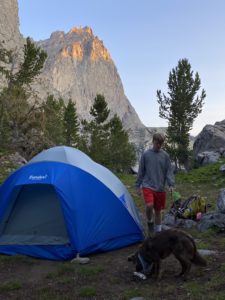
Last night at camp.
We had a great hike out and shared more great conversation, mostly about Fin’s favorite movies, actors and musicians. During one final snack break, with about three miles left, I asked him to use the letters of E.P.I.C. to come up with 4 things he’d like to have in his life to make it epic. He took just a few minutes and responded with, Eating, Playing, Inspiration, and Courage.
I told Fin again how much this time with him in the wilderness meant to me, and how much it would always mean to me. I told him how much I loved him, and to always feel my love and support. I told him I was proud of him and the man he’s becoming, and I wondered if he would mind if I called him Finis occasionally. He said that would be fine, which made me think of what my dad likes to call Fin, which is “Mighty Fine.”
As we continued down the trail, I watched him as he walked in front of me. Such a big boy. My Finis.
I recalled the last words from Finis Mitchell’s “A Mountain Man” prayer: May the winds that blow his way be always mild and the rains that fall upon him be warm and gentle. May the path he selects to follow through life be decorated with lilacs so the beauty and fragrance of the land be with him all the days of his life. May God be with him along his way and guide him through the darkest nights.
I prayed these words for my Finis.
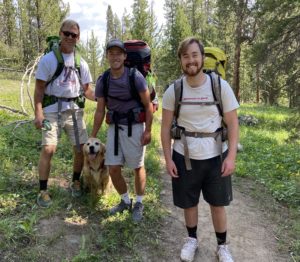
For the last mile, the rest of our crew hiked into to surprise us and to take loads off our backs. (Jerry, Hayden, Wolf, and Buddy.)
Soon after, I noticed a golden retriever up ahead, which made me miss our Buddy. Then, I realized it was our Buddy! Jerry, Hayden, Wolf and Buddy had hiked in to meet us for the end of our adventure. We were thrilled to see them! Wolf and Hayden took the loads off our backs. They gave Fin an ice cold Dr. Pepper and there was an iced coffee for me. Buddy tackled Fin and I, and Chewy tackled Jerry, Wolf and Hayden.
It was the perfect end to a perfect adventure.
- Categories: Adventure, Family, Fitness, Life and Leadership, life coaching, Travel
- Tags: children, epic adventure, finis, finis mitchell, mother son, motherhood, parenthood, parenting, rite of passage, shelli johnson, son, tradition, wind river range, wind rivers, wyoming
- Comments: 7 Comments
October 6th, 2020
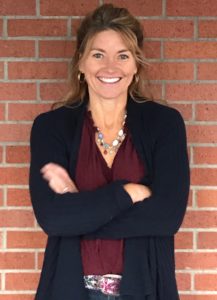
Hi there!
Sometimes my life probably appears to be perfect. Especially on Facebook. It’s not perfect, but at least right now, my life is pretty amazing. (For what it’s worth, everything I post on Facebook is true; I don’t work to make my life look better than it is.)
That said, I’m human, and like everyone, I suffer depressive moments and hardships. (If I had been active on Facebook 10-12 years ago, my posts would look very different from my posts these days. Actually, unless I’m asked, I don’t like to talk about my problems, so probably I would have been “hiding,” and not very visible on Facebook back then.)
Josh Waitzkin, a former chess champion, and author of the awesome book, The Art of Learning, once said in an interview, “There is no such thing as good weather or bad weather, only weather.” The same could be said for life. It’s full of depressions and celebrations. Nobody’s life is perfect, not even my current one, which, as I said, feels amazing.
When I share with coaching clients, or friends, or groups I present to about my vulnerabilities, failures and about why my current blessed life is “hard earned,” people often respond with surprise – and relief. They wouldn’t have guessed my life was me-sy because unless you’re one of the aforementioned, you often don’t see that part of the “profile.” So this blog post will share about something near and dear to me – the importance of daring to fail, and in sometimes failing, including some of my messier parts. (There is a lot more where this came from, and I’m happy to share more personally if you’d email me and request it.)
One of my darkest times was during a time when I had so much to celebrate… We had sold our company of 15 years to a company I respected, and suddenly I had time, additional security, and very importantly, the opportunity to reinvent myself.
There’s a quote from Dov Seidman, CEO of LRN, in Thomas Friedman’s fantastic and important book, Thanks for Being Late: An Optimist’s Guide to Thriving in the Age of Accelerations: “When you press the pause button on a machine, it stops. But when you press the pause button on human beings they start.”
When I suddenly had time, and my pause button was pushed, I found I had a lot of hard personal truths to confront. Such as: I was overweight, sedentary, addicted to technology, drinking wine on too many weeknights, and depressed. For two years, every night after Jerry and the boys were asleep I’d beat myself up (in the form of self loathing) about the fact I let another day go by without taking a step to improve my health, and to get re-engaged in my family and my life. To get conscious again. This self loathing stemmed from a feeling of deep regret – for not taking action at something that could be life-altering, and that, in fact, was in my control.
I share this because I don’t know about you, but for me, nothing motivates me more than my not wanting to have any regrets. I’ve been there, and it was paralyzing, and an awful place to be.
I have recovered from the earlier bout of regret and self loathing, but life will always have some mess and heartbreak and hardship in it. I know this. It is for certain.
While I’m healthy and hopefully only midway through my life, for all I know, I may not wake up tomorrow. So I’m not going to take any chances. I think one of the hardest things any of can do is dare to live the life we are yearning to live – our life, not the life others expect us to live. Not a life where we play it safe. In fact, ironically I think we can risk our life by not living it. (One of the greatest regrets of the dying is that they didn’t have the courage to live their life, rather than a life others expected them to live, or a life that was safer and easier.)
Speaking of regret, when you talk to people who are approaching the end of their life, and you ask them, “What, if anything, do you regret?” most of the time, they list the things they didn’t do that they wish they could do that they can no longer do. In other words, they regret their inactions more than their actions.
What is something you’re wanting to do, but you’re not doing because you’re afraid? Take a minute and think about that. I know there is at least something that will come to mind if you’re honest with yourself.
Despite a range of life and work experiences, and expertise, I don’t consider myself an expert on anything. But I love to learn, and, I am pretty good at it. And thanks to the more than 200 individuals I’ve coached in the last six years, including the 100+ people I’ve led on wilderness adventures, I’ve learned a lot.
Here is one of the most important things I’ve learned: The number one reason we don’t do the things we want, need, or could do is because we are afraid. When I ask people, What are you afraid of? Almost always I hear, “That I will fail.” And when I drill down even further and ask, What do you mean by fail?, One or more of these are what I almost always here in response:
-I’m afraid I will fail. The thing will not be success, and I may not be able to recover.
-I’m afraid I will disappoint others.
-I’m afraid I will disappoint myself.
-I’m afraid I’ll look bad or that I’ll make a fool out of myself. I’m afraid I won’t know what I am doing, and that I won’t have what it takes.
By the way, I use all of the above excuses, too. I have things to share on each of these, including some things I’ve never shared publicly before, so I hope you’ll read on. Thanks in advance if you do.
I’m afraid I will fail. The thing will not be success, and I may not be able to recover.
Well, first off, we learn more from our failures than successes. There’s the saying, “Win or Lose” and “You win some and you lose some.” I can’t recall who said this, but someone suggested we change those sayings to “Win or Learn,” and “You win some and you learn some.” I love the suggested modifications.
I have written about it before, but as an adult, my first significant failure was losing my Division I basketball scholarship at University of Montana. I just wasn’t good enough, and the coach told me this much, and my scholarship went to a more capable player. I’m 52 now, and while I know a basketball scholarship is not a big deal, at the time, when I was just 21, it was a big deal. It was devastating. Feeling like a failure, and far from home, I suddenly found myself without a map. You can read the blog post about that, but, in short, as a result of that failure, I started hiking, I started spending time in solitude, first out of necessity but later out of desire, and I fell in love with reading. It was 28 years ago that I lost my scholarship, and for the past several years, hiking, solitude and reading have been tremendous sources of inspiration for me, and are critical components of my work and mission here at Epic Life Inc. I don’t think these three things would have become important, or that my life would be as amazing as it is today, had I continued riding the bench and having basketball play such a big part of my life. So, like so many people would say of their failures when looking back at them, my first significant failure turned out to be one of my biggest blessings.
I have also failed financially. My husband, Jerry, and I, got into deep personal financial struggles early in our marriage. In 1995, year three of our marriage, we had racked up almost $40,000 in personal credit card debt. In the beginning we joked that the debt was worthwhile because the the start of our debt had accumulated as a result of our using credit cards to pay for long distance phone bills and plane tickets during our two year, long-distance courtship from 1990-1992. But by 1995, it was no joke. We weren’t laughing, but crying. We sold our first home, and downsized to a very tiny and humble (a little better than a shack) of a house. It took a lot of humility to do that, but we were determined to turn things around for ourselves. It took four years, but we were able to fix up the small house, and pay off our debt with the equity from its sale. Today, we have financial skills we would not have developed if not for that financial failure early on in our marriage and partnership. It was during those financial struggles that Jerry and I committed to eating out only one time a month. Now, more than 20 years later, and the parents of three sons, ages 13, 18, and 20, except for when we’re traveling, we still hold fast to that rule, along with other restraints and financial habits we developed only as a result of overcoming our financial failures. Oh, and today, I am happy to report that we are free of debt.
We also had many failures along our way to success with our first business, Yellowstone Journal Corporation and YellowstonePark.com. We started that company in 1995. The first year we generated a whopping $18,000 in revenue. Over the course of 15 years, we failed a lot, and ate a lot of bread and water for meals, but we always recovered stronger and wiser, and eventually sold the company in 2008 to Active Interest Media.
Now I’m in my 6th year of our second venture, Epic Life Inc, and while being an entrepreneur and running and growing my own business is challenging, I’m so much wiser as a result of all of the struggles during the first go-round, and I’m more resilient when I do run into struggles or failures.
I’m often hired as a keynote presenter and/or speaker. (I prefer to call myself an inspired speaker rather than a motivational speaker) Often people will come up to me after my presentation, and ask how they can do the same work as I do, to which I respond by saying, “I’m a 30-year overnight success.” None of what I have has come easy, and I would argue that most of what’s great in my work and my life has come largely as a result of daring to fail, failing often, and learning more, and developing into a better person and leader as a result of both the daring to to fail, and the failures.
And if we’re committed to fulfilling our potential and to a self actualizing life, we must acknowledge that we will never have arrived. Life is one big journey that is full of both depths and heights.
Along those lines, I am happy(?) to report I’m currently as fallible as ever. In fact, just last year, while leading my flagship program, the Epic Women Wind River backpacking adventure, I made a leadership error. Even after years of leading expeditions and having expertise and knowing better, I made an unexpected mistake. The learning is never over, and I have learned to be humble enough to know this, and to learn as much as I can when I do fail.
I gave up Facebook for 30 days, and “failed” on at least four days when I found myself – you guessed it – on Facebook. I caught myself almost immediately, but only after a little perusing…
I fail as a parent, and as a wife, on a regular basis. I have failed in friendships, and other relationships. I I am likely failing at a couple of things right now, today…
Finally, one final item to share under the “I’m afraid I will fail” excuse. I led a Mt. Whitney co-ed expedition for 10 men and women a few years back. I partnered with a guiding company in the Sierras. Well, as a long-time adventurer, and adventure guide, if I’ve learned anything, it’s that seldom does an adventure go exactly as planned. But my co-ed Epic Whitney expedition had all kinds of challenges. The weather was a huge factor. By the time our 4-day expedition came to an end, we had gone from Plan A, to Plan B, to Plan C and finally to Plan D, which didn’t look anything like our Plan A.
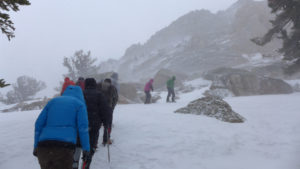
Mt. Whitney. The summit was a No Go.
The year before, during the exact same dates, I went on the same expedition with Backpacker Magazine as part of a Summit for Someone fundraiser for Big City Mountaineers. Everything went better than planned. It went so well that we spent almost 2 hours lounging like marmots under a blue sky on Whitney’s summit. The expedition was inspiring, and it was also a blast. But can you guess which Mt. Whitney expedition developed me more as a leader and as a person? Hands down the second one that went through 4 iterations, and involved 60mph wind gusts, winter blizzards and below zero wind chill – oh, and not standing on top of a mountain. To be sure, we wouldn’t choose these failures, but I personally wouldn’t trade them for anything.
As my partner in the Mt. Whitney expedition so eloquently stated, “The journey is for the soul, the summit is for the ego.” Cheers to the journey, which will almost certainly include some failing.
And trust me, the best, most impactful people and business leaders fail often. They’re not special. They aren’t immune to failure, and in fact, they have the same fears we do.
But don’t just take my word for it – take Adam Grant’s. Grant is the author of two of my favorite leadership books, Give and Take, and Originals. He is also the top-rated professor at Wharton Business School. (Check out these Ted talks, Are You a Giver or a Taker? and The Surprising Habits of Original Thinkers.) While researching and writing Originals, Grant sat down with some of the most original entrepreneurs of our time, including Larry Page, Elon Musk, Jack Dorsey and Mark Cuban. Grant writes, “When I asked them to take me back to the early days, they caught me off guard. They all felt the same fear of failure that the rest of us do. They just responded to it differently.
“When most of us fear failure, we walk away from our boldest ideas. Instead of being original, we play it safe… But great entrepreneurs have a different response to the fear of failure. Yes, they’re afraid of failing, but they’re even more afraid of failing to try.”
Grant was talking about business when he wrote the above, but it applies to our personal endeavors too. All entrepreneurs are human beings, after all.
By the way, I’m even more inspired by a person’s willingness to be brave and vulnerable than I am by his or her greatness. Daring to fail takes daring, and that daring is inspiring to witness. When we dare to fail, we inspire others to dare to fail.
I remember an expedition where we climbed four mountains. One man had never climbed a mountain before, and I hiked right in front or behind him on the first mountain we climbed. The climb took several hours. Every single step the man took was full of fear. His fear was palpable. He was stepping out of his comfort zone and into his potential thousands and thousands of times during what was a 10-hour effort.
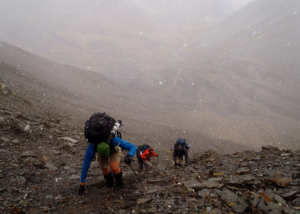
Climbing mountains in high winds, on loose terrain and in a blizzard.
The late Abraham Maslow, an American psychologist who developed ideas related to the “hierarchy of needs,” said, “In any given moment we have two options: to step forward into growth or to step back into safety.”
When we dare to fail, we’re stepping forward into growth. We’re not playing it safe. We’re showing up even though we’re scared, and we’re not playing small. We’re afraid, and we’re proceeding anyway.
One final and important bit about failure. Let’s not be reckless. I’m not recommending being reckless in our daring to fail. No, we must dare to fail with tremendous care. When I work with leaders who are about to launch a new program or product, or who are considering making a major change, we often do an exercise called a pre-mortem. This is basically the act of articulating and writing down your worst fears, the worst case scenarios. I do this same work with my life coaching clients. Often, just by acknowledging and listing our fears, we realize they aren’t as great as we were previously making them out to be. But just as important as acknowledging worst case scenarios, is our need to have ideas for what we do should any of our our worst fears come true.
I recently watched Alex Honnold present here in my hometown of Lander, WY, about his solo climb of El Capitan with no rope. His is an astonishing feat, and it was incredible to see him in person and to meet him. Honnold was saying that in preparation for the challenge (where the stakes are literally his life), he invested significant time climbing the route, and memorizing the moves for the entire 3,000-foot-long route. After the presentation, I went up to Honnold, and asked him more about his process. He explained that he not only rehearsed and memorized the moves of the route, but also visualized and imagined all the “what could go wrongs,” so that on the day of the big event, he felt ready and not afraid.
Tim Ferriss promotes a system the Stoics were famous for. Ferriss calls the process of examining one’s fears as “fear setting,” and he shares his process.
Finally, I think we ought to look back on our life and our work path, and look for, and reflect on our “failures.” Think of one of them, and examine it for lessons you learned, and how that failure may be continuing to inform your life in a positive way. Rinse and repeat. In my experience, this is such fascinating, and useful work, not to mention we can make all kinds of new discoveries about ourselves, and our life.
These failures make for such interesting stories, and they can help and inspire others when we share them.
A Princeton professor, Johannes Haushofer, published a CV listing his career failures on Twitter, in an attempt to “balance the record.” I think keeping a “resume of failures” is a brilliant idea. Otherwise a resume or CV doesn’t tell the whole story. “Every resume and bio that you put together is basically just stringing one success next to another, and we erase all the failures in between,” explains Adam Grant, who keeps a resume of failures after being inspired by Haushofer.
I’m afraid I will disappoint others
First off, the feeling of disappointment is one of my least favorite. And I care deeply about people. So the threat of causing others disappointment is a legitimate and understandable fear.
Good human beings, which describes everyone I know and work with, are always concerned about others. They care for people, and don’t want to disappoint them or let them down. As a result, we often don’t do things we want, need or could do because we just can’t bear to risk letting others down.
But I’ve learned that those “others” in our world, whether they’re our friends, family members, co-workers, or colleagues, prefer that we take chances. They trust we’ll give it our best and that we’re not out to disappoint them.
Think about your friends, family, co-workers and colleagues for a minute. Do you think they’d prefer you take chances and try things that are challenging that will make you better and smarter and more fulfilled, or do you think they’d prefer you play it safe and play small and take no chances.
Marianne Williamson has a great quote that is probably famous because it rings true for so many of us, even if its truth can be inconvenient: “Our deepest fear is not that we are inadequate. Our deepest fear is that we are powerful beyond measure. It is our light, not our darkness that most frightens us. We ask ourselves, ‘Who am I to be brilliant, gorgeous, talented, fabulous?’ Actually, who are you not to be? You are a child of God. Your playing small does not serve the world. There is nothing enlightened about shrinking so that other people won’t feel insecure around you. We are all meant to shine, as children do. We were born to make manifest the glory of God that is within us. It’s not just in some of us; it’s in everyone. And as we let our own light shine, we unconsciously give other people permission to do the same. As we are liberated from our own fear, our presence automatically liberates others.”
I’m afraid I will disappoint myself
I said at the beginning that I don’t consider myself an expert at anything. I want to take that back. I’m an expert at self criticism. I’m a master at it. I’m very hard on myself, and my expectations for myself are often so high that they’re unachievable.
I’m here to report that almost 100% of the people I’ve coached, or led into the wilderness on adventures, tend to be self critical. We often don’t see this in the people we know or admire. On the outside they appear strong and confident. I bet I appear strong and confident. But inside, there’s a whole different story being told.
I’ve taken many leaders up mountains they didn’t know how to climb. As hard as it is for them to climb a mountain they don’t know how to climb, there’s one thing that’s even harder: Fighting the personal narrative that is often, during times of struggle, a negative one. Most of us battle the inner critic, self doubts that flood our minds when we’re doing something hard that we’re not certain we can do. It’s that voice that’s yelling at us inside, right in the crux of our struggle, saying things like: “You gotta quit! You’re going to die! You look like a fool! You’re holding people up. Whose idea was this? You can’t do this. What were you thinking?” And on and on and on. Fill in the blank with your own inner critic monologue.
Stanford University psychologist Kelly McGonigal has done a lot of research and work related to self criticism. I listened to a series of audio files by her a few years back and found her work about self criticism and self compassion to be informative and hopeful. In short, McGonigal says self criticism is not motivating. We just tell ourselves that it is. We think that if we give ourselves a good butt-kicking, it will motivate us to do more and better. But McGonigal says it’s just not true. She argues that self compassion is more motivating.
Loving ourselves, although that should be a top priority for all of us, can seem like too big of a stretch for those of us who are self critical. Self compassion is a better first step, I think.
There’s that wonderful saying, “Treat others as you’d like to be treated.” I endorse this message. But I’ve added my own twist, that I often share with people I work with and care about, and that is: “Treat yourself the way you’d like to treat others.” This constructive behavior toward self during struggle and doubt can make the challenging experiences in our life and work more tolerable and, in the end, more worthwhile. It can also be the difference between quitting and hanging in there when we really, really want to hang in there.
So many times when I’m leading a person up a mountain, or through any wilderness situation that’s challenging, a person who is struggling will be encouraging to all of those around her or him, while inside unleashing the wrath of the criticism on himself or herself. Like I said, these same people are often loving and supportive and compassionate to others. So we know how to encourage. We have that skill. We simply have to turn that skill onto ourselves, and when we do, it makes all the difference. It’s not easy work, but it’s worthwhile work.
One final thought on this fear of disappointing our self… There’s a quote by Terry Tempest Williams, from her wonderful book, The Hour of Land and it is, “Wilderness is an antidote to the war within ourselves.” Hear Hear. One of the main reasons I love using the wilderness as a platform from which my clients can practice doing the hard work that living our epic life and being our best requires is because in the wilderness we can’t run from our self. We can’t hide. During adversity, we are forced to confront our inner critic. In real time, during those struggles, we learn new, gentler, more compassionate ways to be with our self that then carry over into other areas of our lives after the adventure has ended.
The last thing I want to say on this fear of disappointing ourselves, is often the disappointment we have in ourselves is a result of the comparing we do. We compare ourselves to those around us, and then we are disappointed when we don’t measure up. We need to stop comparing. Theodore Roosevelt said, “Comparison is the thief of joy.” Byron Katie says, “Without comparison, our life is perfect.” If you want to be disappointed or miserable, just start comparing yourself, and your life, to others.
Finally, in my experience, we are much more likely to be disappointed in ourselves when we don’t do the thing we are yearning to do than when we dare to do it.
Designer, author and professor Debbie Millman said something on a recent podcast interview that I haven’t quit thinking about. She asked this question: What are you more afraid of – regret or rejection? Regret will be my answer every time. I think Millman’s is a great question to think about.
I’m afraid I’ll make a fool out of myself. I don’t know what I am doing. I’m afraid I’ll look bad
My friend, Trevor Ragan, perhaps says it best. He says “Getting better and looking good don’t happen at the same time.” Amen to that. Let’s just acknowledge this fact, and agree to look bad every now and then so we can get better. Deal? I’m in.
When I recall all the times I feared I would look like a fool, and/or did look like a fool, I can’t help but think of when I decided I wanted to learn how to skate ski. I didn’t take a lesson; I just rented the gear and went to our local golf course where there were groomed trails. I’m athletic, but skate skiing is very physically demanding and technically challenging to learn. I had not a clue what to do and I fell no fewer than 1oo times in an hour. It was ugly, and painful, and it was humiliating. But I’m so glad I did that. I’ve been skate skiing for six years now and it’s one of the reasons I love, and can tolerate our long winters.
So daring to fail means being willing to look bad.
As I mentioned before, I’ve led people up mountains who didn’t know how to climb a mountain. In July of 2013, I led my first Epic Women backpacking program. On Day 2, we let the eight women – none who had ever climbed a mountain – lead us up a tall mountain. They didn’t have mountain climbing skills, or experience at high altitudes. The process was therefore laborious, and the women were at times apprehensive. The ascent took longer than if the guides or I led us up the mountain. And, our chances of summiting were lower also, since summit attempts are limited by changing weather so the longer the effort takes, the lower the chance we’ll be able to continue toward the summit. But if the goal is to develop the women’s skills and leadership, then it’s worth it. We made it to the top, and the result was not only the accomplishment of standing on the summit, but even more importantly, each woman, and our entire expedition team was more than we were before.
I’m coaching two people who have cancer. It is meaningful work, and I want to do more of this work. But often, during a call with one of these people, I find myself telling myself, “I don’t know how to do this.” I don’t, but I’m listening and I’m giving it my best. I am learning by daring to fail.
Daring to fail, even though it means risking looking bad, and looking like a fool, and stumbling our way through, is about becoming actually what we are potentially.
I think it was Charlie Chaplin who said, “Failure is unimportant. It takes courage to make a fool of yourself.”
But my favorite quote for this section of the blog post is something said by my friend, the late Todd Skinner, who was a world-famous, big wall climbing legend, and an amazing human being: “We cannot lower the mountain, therefore we must elevate ourselves.” The best way to learn how to do something is to dare to do it, even if you don’t know how to do it.
In closing, I want to go back to something I said earlier in the post.
When you talk to people who are approaching the end of their life, and you ask them, “What, if anything, do you regret?”, do you know how most of them respond? Most of the time, they list the things they didn’t do that they wish they could do that they can no longer do. They regret their inactions more than their action. They regret the things they did not do.
This is so important for us to remember. Let’s not be sorry for not doing something we wanted to do because we were afraid.
Here’s to all of us daring to fail more often. Here’s to leading a more fulfilling life. Here’s to having more interesting stories to share. And finally, here’s to not having any regrets – now, or in the end!
Thank you so much for reading.
Part of my work is keynote presenting. I’m hired by organizations or events to deliver my keynote presentation, “Epic Lessons Learned in the Field.” I also provide leadership development training and facilitation. One of the workshops I’m most passionate about is DARE TO FAIL. I also have a little availability right now for coaching if you or anyone you know would like to have someone dare, support and hold them accountable in making some positive changes in their life or leadership.
Email me if you’d like to learn more about any of these offerings. Thanks!
- Categories: Adventure, Family, Fitness, Life and Leadership, Travel
- Tags: adam grant, daring to fail, failure, fear of failure, growth mindset, Leadership, regrets
- Comments: 11 Comments

















